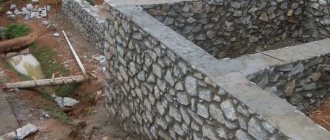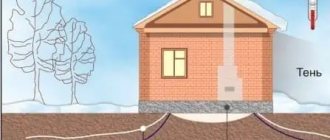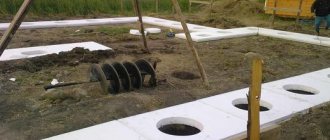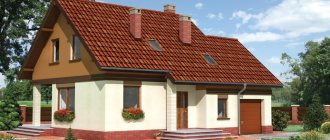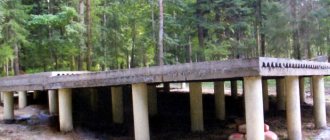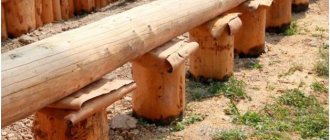Construction of a glass-type foundation
The glass-type foundation is a prefabricated structure made of factory-produced reinforced concrete blocks. Such blocks consist of two parts - a base base plate and a pyramidal shaped column (shoe) emerging from it with a cavity in the central part, in which the reinforced concrete column is fixed.
Figure 1.1 : Reinforced concrete blocks for a glass foundation
Important! Glass blocks, depending on the location of the column installation, can have a central and lateral load. The base plate in blocks intended for central loads has a square cross-section; for lateral loads, rectangular slabs with an aspect ratio of at least 0.6 are used.
The cross-section of the shoe depends on the size of the column installed in it. Standard products are produced for columns with a cross-section of 300 and 400 mm, their dimensions increase in increments of 100 mm. The minimum thickness of the bottom wall of the shoe is 20 centimeters.
The production of glass-type foundations is regulated by the requirements of GOST No. 24476-80 “Precast reinforced concrete foundations”. This regulatory document puts forward the following requirements for glass bases:
- All elements of the prefabricated structure must be made of concrete grade M200, which corresponds to water resistance group B2 (moisture absorption of no more than 5% of its own volume);
- The sole and sub-column are subject to mandatory reinforcement. To strengthen the slab, reinforcing mesh of the 1.410-3 series is used, and hot-rolled reinforcement of class A2 and A3 is used to strengthen the column supports.
Important! In addition to the rod reinforcement, the sub-columns are also reinforced with a reinforcing mesh, from which a three-dimensional frame is formed, located along the four walls of the shoe to their entire height. When strengthening a glass foundation, the reinforced frame is recessed into the concrete at least 5 centimeters.
Figure 1.3 : Scheme of glass foundation reinforcement
About the application of grounds
1. The components are formed from heavy reinforced concrete, but the pressure on the soil is minimal, thanks to the precisely calculated location of the supports. Reliability is high thanks to the well-thought-out distribution of lateral and longitudinal loads.
2. Concrete blocks, pillars, columns are produced in a factory where every technological instruction is strictly followed, so the quality is maintained at a decent level.
3. Installation is carried out quickly because the reinforced concrete elements are equipped with mounting loops. In this case, one cannot do without the use of powerful lifting equipment, since the weight of all parts of the foundation is quite large.
4. If necessary, the prefabricated structure can be disassembled and moved to the desired location.
Despite the fact that reinforced glasses and pillars are massive and dimensional, the total cost is much lower than the price of a tape running along the entire perimeter of the building.
Types, sizes and technical requirements
Glass foundations are classified depending on the characteristics of the supporting blocks. The differences between them are in size, grade of concrete used to make the support, and method of fixing the column to the shoe. In our country, the technology of filling it with a concrete mixture of class M200-M300 is popular, but sometimes a fastening scheme with anchor bolts is used.
According to GOST 24022-80, foundations are divided into three types, depending on their design and the cross-section of the square column:
- 1F – 300x300 mm;
- 2F – for dimensions 400x400 mm;
- 3F – trapezoidal design 400x400 mm.
The type is identified by its load-bearing capacity. An example of the marking of one of the standard blocks (2F-15-15-2) and its explanation:
- 2F – glass foundation, dimensions of a suitable column – 400x400 mm;
- 15 – the rounded lengths of the sides of the supporting sole of the glass are 15 dm (1500 mm);
- 15 – height of the mounting hole in the column – 15 dm;
- 2 – type of foundation, taking into account its load-bearing capacity.
Designs of blocks according to GOST 24022-80 are shown in the figure, and their dimensions are given in the table:
If there is a letter P at the end of the marking, then the element is made of hydraulic concrete, belonging to the water resistance group B2.
The standard imposes the following requirements on blocks.
- The grade of concrete mixture is not lower than M20.
- Possibility of transportation to the site only after the concrete has reached the standard strength indicator.
- Mandatory reinforcement for the sole and column. The slab is reinforced with mesh 1.410-3, the glass is reinforced with hot-rolled reinforcement A2 and A3. The minimum thickness around the steel frame is 3 cm; it is unacceptable for the reinforcement to be exposed - this is considered defective.
- Prohibition on the use of glasses with cracks larger than 0.1 mm.
Where is a glass-type foundation used?
The glass foundation is classified as a shallow foundation; during its construction there is no need to carry out a large amount of excavation work. Due to the fact that the entire structure is delivered from the factory in a form ready for installation, it is possible to install the foundation itself and erect the floors and walls of the building in the shortest possible time. After installing a glass foundation, there is no need to wait a pause in construction work, as is the case with monolithic foundations, which require a month of downtime for concrete to harden.
The above advantages are the key factors determining the demand for glass foundations in industrial construction . Such foundations are indispensable when arranging agricultural premises - pigsties, cattle stalls, chicken coops, storage facilities for crop products.
Figure 1.4 : Using a glass foundation in the construction of a two-story industrial building
Glass foundations are also used in the construction of infrastructure industrial facilities - warehouses and hangars, garages, sewage stations.
In road construction, glass foundations are used in the construction of bridges, and they are also often used in the construction of basement condensation floors at nuclear power plants.
Important! In individual construction, glass foundations are used extremely rarely due to their high cost. Some types of frame houses can be built on it, but for private development the use of a pile foundation is preferable in all respects.
Types of glass foundations
The classification of glass-type foundations is carried out depending on the structural features of the blocks used. They may differ:
- By dimensions;
- According to the method of connecting the column to the shoe.
Reinforced concrete columns of square cross-section are fixed in glasses using concrete mortar of class M200 and M300. There is also a technology for fastening columns using anchor bolts, but it is not widely used in domestic construction. Metal columns are joined to the glass by welding with the outlets of the column reinforcement.
Figure 1.5 : Main brands of blocks for glass foundations according to GOST
Types of glass blocks, according to GOST standards No. 2447680, are determined based on overall dimensions and load-bearing capacity. All foundations have a unified marking; let’s consider it using the example of a glass foundation 1F 13-9-2:
- 1F - glass foundation for a column with a section of 300*300 mm (2F - for a column 400*400 mm);
- 13 - cross-sectional area of the supporting sole, rounded to decimeters (in this foundation it is 1300 * 1300 mm);
- 9 — height of the seat in the column;
- 2 - type of foundation according to the load-bearing capacity of the structure.
Expert advice! Also, glass blocks can be divided into types depending on the hydrophobicity of concrete, if the product corresponds to water resistance group B2, its marking does not contain any additional indicators, however, if concrete has reduced water permeability, this is indicated by the letter “P” at the end of the marking.
Prefabricated reinforced concrete foundations for columns SMF-80 issue 1
Characteristics: The foundations are intended for use under columns: - administrative - domestic buildings of the II-04-2 and 1.020-1/87 series; — multi-storey industrial buildings of the II22-1;2.3/70 series; — one-story industrial buildings of the KE-01-49, KE-01-52, 1.420-12,1.423-3,1.424.1-5, 1.425-5 series. The foundations are designed for use in dry and water-logged soils when the base of the prefabricated foundation slab is laid below the frost depth.
| Product brand | Dimensions, mm | Concrete grade (Concrete class) | Volume of concrete, m3 | Product weight, t | ||||
| A | b | c | k | h | ||||
| 1SS | 1000 | 1350 | 600 | 700 | 1000 | M200 (B15) | 0,97 | 2,4 |
| 2SS | 1000 | 1550 | 600 | 900 | 1000 | M200 (B15) | 0,97 | 2,4 |
| 3SS | 1000 | 1800 | 600 | 1100 | 1350 | M200 (B15) | 1,41 | 3,5 |
| 4SS | 1200 | 1200 | 700 | 1500 | 1350 | M200 (B15) | 1,93 | 4,8 |
Characteristics: The foundations are intended for use under columns: - administrative - domestic buildings of the II-04-2 and 1.020-1/87 series; — multi-storey industrial buildings of the II22-1;2.3/70 series; — one-story industrial buildings of the KE-01-49, KE-01-52, 1.420-12,1.423-3,1.424.1-5, 1.425-5 series. The foundations are designed for use in dry and water-logged soils when the base of the prefabricated foundation slab is laid below the frost depth.
| Product brand | Dimensions, mm | Concrete grade (Concrete class) | Volume of concrete, m3 | Product weight, t | ||||
| A | b | c | k | h | ||||
| 1SS-2 | 1000 | 1350 | 600 | 700 | 1000 | M200 (B15) | 1,03 | 2,6 |
| 1SS-1l | 1000 | 1350 | 600 | 700 | 1000 | M200 (B15) | 0,95 | 2,4 |
| 1SS-1p | 1000 | 1350 | 600 | 700 | 1000 | M200 (B15) | 0,95 | 2,4 |
| 2SS-2 | 1000 | 1550 | 600 | 900 | 1000 | M200 (B15) | 1,07 | 2,7 |
| 2SS-1l | 1000 | 1550 | 600 | 900 | 1000 | M200 (B15) | 1,01 | 2,5 |
| 2SS-1p | 1000 | 1550 | 600 | 900 | 1000 | M200 (B15) | 1,01 | 2,5 |
| 3SS-2 | 1000 | 1800 | 600 | 1100 | 1350 | M200 (B15) | 1,57 | 3,9 |
| 3SS-1l | 1000 | 1800 | 600 | 1100 | 1350 | M200 (B15) | 1,48 | 3,7 |
| 3SS-1p | 1000 | 1800 | 600 | 1100 | 1350 | M200 (B15) | 1,48 | 3,7 |
| 4SS-2 | 1200 | 1200 | 700 | 1500 | 1350 | M200 (B15) | 2,09 | 5,2 |
| 4SS-1l | 1200 | 1200 | 700 | 1500 | 1350 | M200 (B15) | 2,00 | 5,0 |
| 4SS-1p | 1200 | 1200 | 700 | 1500 | 1350 | M200 (B15) | 2,00 | 5,0 |
Characteristics: The foundations are intended for use under columns: - administrative - domestic buildings of the II-04-2 and 1.020-1/87 series; — multi-storey industrial buildings of the II22-1;2.3/70 series; — one-story industrial buildings of the KE-01-49, KE-01-52, 1.420-12,1.423-3,1.424.1-5, 1.425-5 series. The foundations are designed for use in dry and water-logged soils when the base of the prefabricated foundation slab is laid below the frost depth.
| Product brand | Dimensions, mm | Concrete grade (Concrete class) | Volume of concrete, m3 | Product weight, t | ||||
| A | b | c | k | h | ||||
| 1SS-2 | 1000 | 1350 | 600 | 700 | 1000 | M200 (B15) | 1,03 | 2,6 |
| 1SS-1l | 1000 | 1350 | 600 | 700 | 1000 | M200 (B15) | 0,95 | 2,4 |
| 1SS-1p | 1000 | 1350 | 600 | 700 | 1000 | M200 (B15) | 0,95 | 2,4 |
| 2SS-2 | 1000 | 1550 | 600 | 900 | 1000 | M200 (B15) | 1,07 | 2,7 |
| 2SS-1l | 1000 | 1550 | 600 | 900 | 1000 | M200 (B15) | 1,01 | 2,5 |
| 2SS-1p | 1000 | 1550 | 600 | 900 | 1000 | M200 (B15) | 1,01 | 2,5 |
| 3SS-2 | 1000 | 1800 | 600 | 1100 | 1350 | M200 (B15) | 1,57 | 3,9 |
| 3SS-1l | 1000 | 1800 | 600 | 1100 | 1350 | M200 (B15) | 1,48 | 3,7 |
| 3SS-1p | 1000 | 1800 | 600 | 1100 | 1350 | M200 (B15) | 1,48 | 3,7 |
| 4SS-2 | 1200 | 1200 | 700 | 1500 | 1350 | M200 (B15) | 2,09 | 5,2 |
| 4SS-1l | 1200 | 1200 | 700 | 1500 | 1350 | M200 (B15) | 2,00 | 5,0 |
| 4SS-1p | 1200 | 1200 | 700 | 1500 | 1350 | M200 (B15) | 2,00 | 5,0 |
Characteristics: The foundations are intended for use under columns: - administrative - domestic buildings of the II-04-2 and 1.020-1/87 series; — multi-storey industrial buildings of the II22-1;2.3/70 series; — one-story industrial buildings of the KE-01-49, KE-01-52, 1.420-12,1.423-3,1.424.1-5, 1.425-5 series. The foundations are designed for use in dry and water-logged soils when the base of the prefabricated foundation slab is laid below the frost depth.
| Product brand | Dimensions, mm | Concrete grade (Concrete class) | Volume of concrete, m3 | Product weight, t | ||||
| A | b | c | k | h | ||||
| 1SS-2 | 1000 | 1350 | 600 | 700 | 1000 | M200 (B15) | 1,03 | 2,6 |
| 1SS-1l | 1000 | 1350 | 600 | 700 | 1000 | M200 (B15) | 0,95 | 2,4 |
| 1SS-1p | 1000 | 1350 | 600 | 700 | 1000 | M200 (B15) | 0,95 | 2,4 |
| 2SS-2 | 1000 | 1550 | 600 | 900 | 1000 | M200 (B15) | 1,07 | 2,7 |
| 2SS-1l | 1000 | 1550 | 600 | 900 | 1000 | M200 (B15) | 1,01 | 2,5 |
| 2SS-1p | 1000 | 1550 | 600 | 900 | 1000 | M200 (B15) | 1,01 | 2,5 |
| 3SS-2 | 1000 | 1800 | 600 | 1100 | 1350 | M200 (B15) | 1,57 | 3,9 |
| 3SS-1l | 1000 | 1800 | 600 | 1100 | 1350 | M200 (B15) | 1,48 | 3,7 |
| 3SS-1p | 1000 | 1800 | 600 | 1100 | 1350 | M200 (B15) | 1,48 | 3,7 |
| 4SS-2 | 1200 | 1200 | 700 | 1500 | 1350 | M200 (B15) | 2,09 | 5,2 |
| 4SS-1l | 1200 | 1200 | 700 | 1500 | 1350 | M200 (B15) | 2,00 | 5,0 |
| 4SS-1p | 1200 | 1200 | 700 | 1500 | 1350 | M200 (B15) | 2,00 | 5,0 |
Glass-type foundation installation technology
Glass foundation blocks are heavy - from 1.3 to 5.8 tons, which requires the use of crane equipment for their installation. In addition to the jib crane and its operator, two installers must be involved in laying the glass foundation.
According to current regulations, the installation time for one glass block weighing one and a half tons should be 27 minutes.
- Stage No. 1 - preparatory and excavation work
The area where the glass foundation will be installed is cleared of construction debris and surface vegetation. If the project provides for the installation of blocks at the bottom of the pit, the soil is excavated using an excavator.
When installing blocks in shallow depths, the pit is excavated to a depth equal to the height of the base plate of the glass block. The pit can be arranged for each block separately, or in the form of a continuous line that follows the contours of the walls of the building.
Figure 1.6 : Glass block placed in a separate pit
If it is necessary to create a compacting bedding, the length and width of the pit should be 30 centimeters greater than the similar dimensions of the base plate. After excavating the soil, the pit is cleaned, its bottom is leveled and compacted.
- Stage No. 2 - arrangement of compaction
The compacting bedding under the glass foundation is made of sand and fine crushed stone. The need for it arises in conditions of low-density soils, which are prone to shrinkage under the weight of the building and foundation structure.
Important! The compacting layer must protrude 30 centimeters beyond the base slab, otherwise the block will not be evenly supported on the preparation, which can lead to distortion of the reinforced concrete structure.
Figure 1.7 : Installation diagram of a glass foundation using a jib crane
The thickness of the compaction varies depending on the weight of the glass block, but under any conditions the thickness of the layer of sand and crushed stone should be identical.
The first layer is crushed stone - it is evenly distributed and leveled at the bottom of the pit. Crushed stone is compacted using a manual compactor or jib crane attachment. A layer of sand is poured on top of the crushed stone, which is watered with water from a hose and compacted in the same way.
- Stage No. 3 - marking the reference axes
At the bottom of the pit, the installation site for the glass block is marked. The alignment axes are secured to the stripping boards using twine or wire with a diameter of 2 millimeters. At the intersection of the axes, a plumb line (weighing at least 0.5 kg) is installed and the central point of the base plate is transferred to the ground.
Rice. 1.8 : Layout of the axes of the glass foundation
Using the dimensional template of the installed slab, the lateral contours of the block’s position are transferred to the ground, which are marked using reinforcement pegs and string stretched between them.
Expert advice! After marking the foundation, the horizontality of the poured layer is checked using a level and leveled to a perfectly level level.
- Stage No. 4 - installation of the block
Before installing the blocks, one of the builders checks the condition of the mounting hinges on the reinforced concrete structures; if they are bent, they are straightened with a hammer.
Next, on the edge of the glass, guidelines are applied using paint, indicating the design sides of the location of the block axes. One installer slings the block, hooking the jib crane cable hooks into the mounting loops. Slinging can be done with two or four hooks, depending on the dimensions of the reinforced concrete structure.
Figure 1.8 : Sequence of installation of a glass foundation
After checking the reliability of the hooks, the installer moves away from the glass to a safe distance and gives the command to the crane operator to lift the block. The lower wall of the raised product is cleared of adhering earth, after which the crane moves the glass to the place of installation.
At a height of 15-20 centimeters above the ground, two installers begin to manually adjust the installation of the block, turning and shifting it in the required direction.
At the command of the installers, the crane operator completely lowers the block to the ground , after which, using crowbars, the builders align its position relative to the marking axes. When the block occupies the required spatial position, the sling is dismantled and the installation of the next structure begins.
